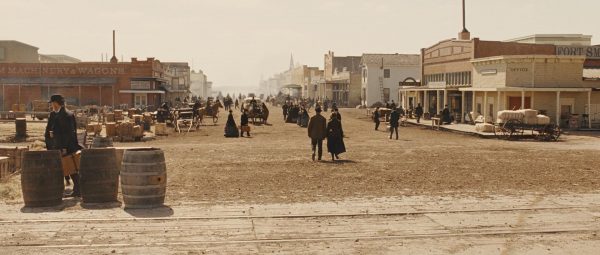This post is intended as a preamble for the list of old west towns.
There were a few main types of towns that prospered in the old west. As with most everything in this world, there is a process of building to something, and then there’s the path leading away from that particular moment in time. Towns in the western frontier were unique because they served a point in time that was unique, and just as everything else, there was a reason they were built and a reason that they went the way they did; whatever that direction may have been.
The most commonly thought of towns in the old west were Cow-Towns and Boom-Towns. It’s true that a cow-town could also be a boom-town, but most often they were essentially separate in their proliferations. In addition to these two types we had trail towns and supply towns. A supply town may not be a boom-town/mining camp, but due to it’s proximity, along with helpful attributes, such as being aligned with a well used trail road, the supply town could see prosperity in a symbiotic relationship to the boom-town/mining camp.
One very common locale in the old frontier days that won’t be included were the military forts. Because it is such an in depth element all of it’s own, and the fact that they were military fortifications, not the places of bar-fights and shootouts, we won’t be including it. However, in a dynamic mimicking the coupling of supply town to mining camps, likewise camp-towns often accompanied the military forts of the west.
Very often a town would spring to life along a commonly used trail. At first it may be nothing more than a trading post, then perhaps the addition of another establishment leads it into becoming a small trail town. Then one day the train makes a stop and now it becomes known for foot traffic arriving by rail, and commonly becomes identified as a train stop town. One interesting case in this is El Paso, Texas. The community existed for some time do to it’s crossing from Jaurez, Mexico. It eventually became a prominent travel hub, being setup as a primary route for those traveling to and from Texas to New Mexico, Arizona, or Colorado. Yet despite the fact that it was such a center-piece for western travel, it didn’t enjoy the trains arrival until May of 1881, where Marshal Dallas Stoudenmire was present to greet the president of the rail company.
For the sake of a bit of easy clarity, I have distinguished between a cow-town and a cattle town. The cow-town being one that prospered from the arrival of the cow-boys and their cows from Texas (or other locations), and the cattle town being a place that prospered from the sale of cattle. For illustrations sake, San Antonio might be considered a cattle town due to the ranchers who owned and sold cattle en mass, and Dodge City, where the cow-boys drove this cattle and wildly celebrated at the end of the drive, would be referred to as a cow-town.
None of these descriptors are encyclopedic presets, they are merely what I have decided on for my own simplified reference points. There were, of course, other types of towns, such as agriculture communities and others, but since these were very seldom locations that drew the gun-toting element, they are very rarely ever mentioned. An example of this could be Phoenix Arizona, which was planned and plotted along the Gila River for agriculture. With it’s differing origins and purposes from Tucson, Prescott, or Tombstone, it’s not one that’s really ever heard of in the annals of the wild west. (As a side note to Phoenix, if you would like a glimpse at the history of Phoenix from the old days, the only remaining building in the original downtown area stands at 2nd & Washington and serves, presently, as a sports bar/night club.) Wichita started out also as an agricultural community, but once the cattle trade started driving there, it became, primarily, a cow-town. This lasted until the cattle industry ventures migrated elsewhere; which brings around another key factor in the life of western towns.
Very few old west towns went on to prominence. Dodge City has maintained, but never became huge. Phoenix became huge, but was never really an old west stomping ground. Denver could be a rare case where a traditional fighting, gambling, whoring community made good and is still impactful today. But with most of these towns there was a trend that was common. First a community would struggle to attract commerce, then, subsequent efforts to attract people would often bring about a rowdy crowd. These were often the cow-boys, the lawmen, the gamblers, rustlers, and everybody in general who saw a chance to make some money. But these classes of citizens were not the desired bedrock of the community and once a town had attracted what it wanted, it began to filter out what it didn’t. This led to the removal or exiting of many of the colorful western element, and left the towns to go their own course.
Today, we, the historically enthused, chase around after these sacred locales, studying and absorbing what they were and what they are. To get a broad snapshot of what the towns were and a few pertinent details, please refer to the Old West Towns List. You can simply look up a town by name, or scroll through the list. The intent is to give a quick, easy idea of what things looked like. You can look at the census for Deadwood and see how it grew, or compare it to Ogallala and others to get an idea of what the town might have looked like at a time when a certain hombre strolled in. Hopefully with a little context and juxtaposition, a better understanding can be had.

